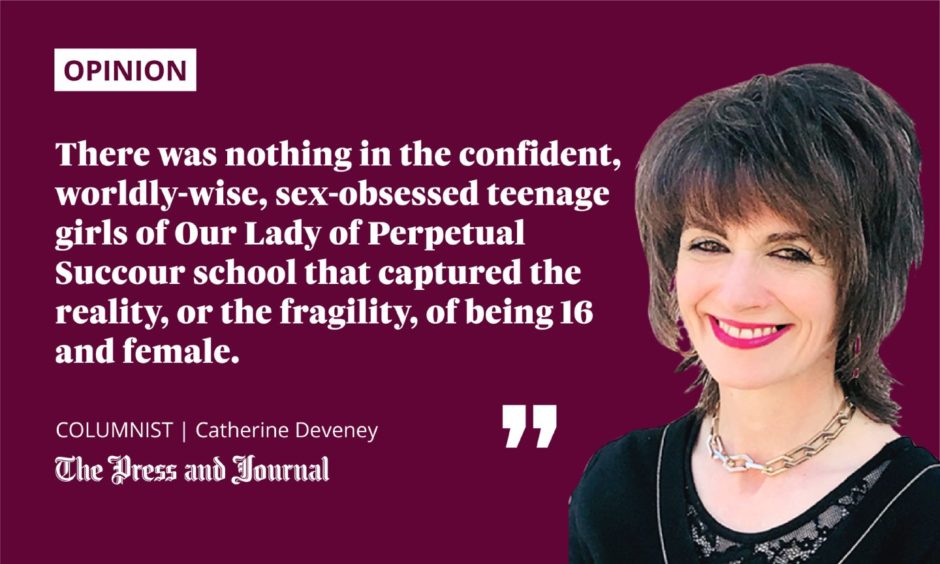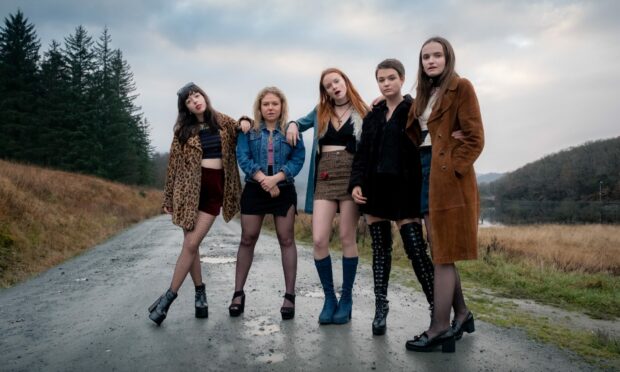There was only once in the year that boy aliens touched down in the hallowed halls of my convent secondary school: the senior school dance. Presumably, we were considered sufficiently mature by then to experience this intergalactic visitation to our weird little all-female planet, though dark warnings about patent shoes reflecting underwear were still offered in semi-seriousness by our headmistress.
Offered in full seriousness was her assessment of the relative merits of the city’s all-boy Catholic schools. The St Aloysius boys, with their trim haircuts and neat green blazers met sister’s approval. The rough St Mungo’s boys – apologies, guys, but please don’t shoot the messenger – were definitely the booby prize. So naturally, all the game gals wanted a Mungo boy.

I ‘get’ Catholic schoolgirl defiance but watching “Our Ladies” this week, the Michael Caton- Jones film about a group of convent schoolgirls running rampage in Edinburgh, left me feeling uneasy. Apart from a Mungo boyfriend, the height of defiance back then was stuffing your school hat into your bag once clear of the premises. Most were too scared even for that, given the doughty matrons of Glasgow had enough time on their hands to ring Sister to complain. Oh, the recriminations that ensued when Mrs Outraged from Kelvinside reported the reprobates she spotted on the subway minus their hats.
Warped thinking of on-screen rebellion
After watching ‘Our Ladies’, which is based on Alan Warner’s novel ‘Sopranos”, I tried to unravel my unease. The scene where the sex-obsessed nymphets lift their shirts at the back of the bus to the work van on the road behind them, and hold up signs saying “shag me”, didn’t make me laugh. Nor did the scene where the older men think their luck is in because everyone knows wee Fenians are more up for it than anyone else. The teenage girls outplay, outsmart and outwit every hapless, exploitative male who crosses their path. No contest? Not on this planet.
The church flattered women into silence, ushering them meekly into cathedral corners with the ease of sheepdogs rounding up their flocks.
The Catholic church’s attitude to sexuality and to women felt dysfunctional, even as a schoolgirl. Women were either Madonnas or whores. Female education was important; female obedience was vital. The church flattered women into silence, ushering them meekly into cathedral corners with the ease of sheepdogs rounding up their flocks. They were valuable. Sacred, even, if they were mothers or celibates. The church depended on Y chromosomes for making tea, laundering altar cloths and arranging flowers. And no they couldn’t have any actual power. They could have a pedestal as long as they didn’t try to step down from it or speak.
It seemed to me watching Our Ladies that the rebellion on screen was just another version of that warped thinking. Following a hunch, I did a quick, informal gender check on film reviews. “A pitch-perfect evocation of the possibilities and frustrations of being young and riotously alive in mid 90’s Scotland,” said the male reviewer.
The female reviewers? “Struggling to get the tone right,” said one, who noted that the bus scene was, “neither funny, sexy nor particularly subversive.” Another noted that the material felt outdated. She might once have seen the schoolgirls’ behaviour as rebellion but no longer. “Now I watch thinking how vulnerable their real-life counterparts are.”
Our Ladies fails to capture fragility of being 16
Her observation about vulnerability strikes at the heart of the issue. The thrill of illicit danger will always be a part of exploratory teenage years. But there was nothing in the confident, worldly-wise, sex-obsessed teenage girls of Our Lady of Perpetual Succour school that captured the reality, or the fragility, of being 16 and female.
No wonder women reviewers are laughing a little less heartily than their male counterparts at a story that when it boils down to it, is the fantasy of a male writer-director.
The truth? A survey by the Child Sex Abuse Centre revealed that one in seven girls in Britain are abused by the age of 16. Last month, new NSPCC figures showed that in Scotland, police recorded 15 child sex offences every single day last year, an increase of 30% in the last five years. Girls are five times as likely as boys to be victims. Against that backdrop, it is frustrating to see the pinnacle of emancipation being depicted as teenage girls beating men at their own game.
The boys at our school dance might as well have been from another planet for all the contact we had with them the rest of the year, yet the girls of Our Ladies handle them like seasoned pros. The film, we were told in one of the publicity interviews, was a rare validation of female dreams and aspirations. Ironic, really. The aspirations sounded remarkably like male ones from female mouths. No wonder women reviewers are laughing a little less heartily than their male counterparts at a story that when it boils down to it, is the fantasy of a male writer-director.
Catherine Deveney is an award-winning investigative journalist, novelist and television presenter
